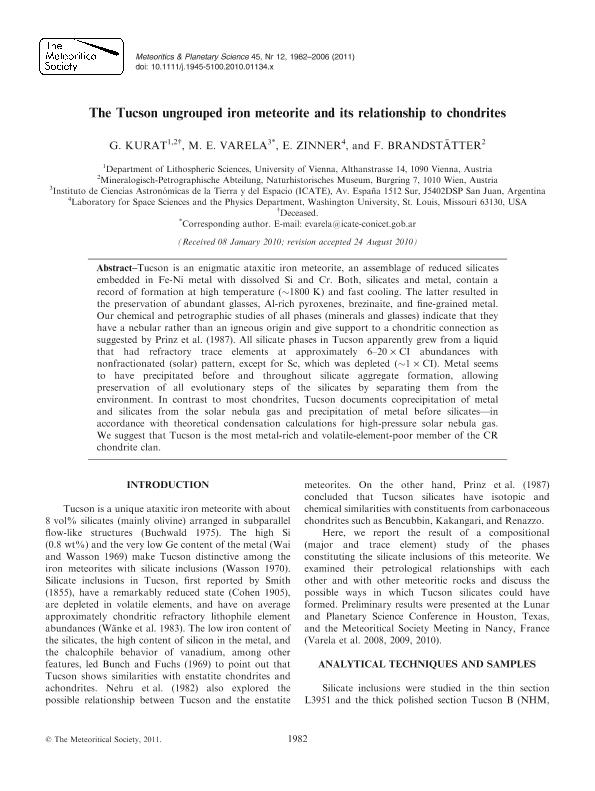Mostrar el registro sencillo del ítem
dc.contributor.author
Kurat, G.
dc.contributor.author
Varela, Maria Eugenia

dc.contributor.author
Zinner, E.
dc.contributor.author
Brandstäetter, F.
dc.date.available
2017-02-14T15:59:57Z
dc.date.issued
2010-12
dc.identifier.citation
Kurat, G.; Varela, Maria Eugenia; Zinner, E.; Brandstäetter, F.; The Tucson ungrouped iron meteorite and its relationship to chondrites; Meteoritical Soc; Meteoritics & Planetary Science; 45; 12; 12-2010; 1982-2006
dc.identifier.issn
1086-9379
dc.identifier.uri
http://hdl.handle.net/11336/12975
dc.description.abstract
Tucson is an enigmatic ataxitic iron meteorite, an assemblage of reduced silicates embedded in Fe-Ni metal with dissolved Si and Cr. Both, silicates and metal, contain a record of formation at high temperature (∼1800 K) and fast cooling. The latter resulted in the preservation of abundant glasses, Al-rich pyroxenes, brezinaite, and fine-grained metal. Our chemical and petrographic studies of all phases (minerals and glasses) indicate that they have a nebular rather than an igneous origin and give support to a chondritic connection as suggested by Prinz et al. (1987). All silicate phases in Tucson apparently grew from a liquid that had refractory trace elements at approximately 6–20 × CI abundances with nonfractionated (solar) pattern, except for Sc, which was depleted (∼1 × CI). Metal seems to have precipitated before and throughout silicate aggregate formation, allowing preservation of all evolutionary steps of the silicates by separating them from the environment. In contrast to most chondrites, Tucson documents coprecipitation of metal and silicates from the solar nebula gas and precipitation of metal before silicates—in accordance with theoretical condensation calculations for high-pressure solar nebula gas. We suggest that Tucson is the most metal-rich and volatile-element-poor member of the CR chondrite clan.
dc.format
application/pdf
dc.language.iso
eng
dc.publisher
Meteoritical Soc

dc.rights
info:eu-repo/semantics/openAccess
dc.rights.uri
https://creativecommons.org/licenses/by-nc-sa/2.5/ar/
dc.subject
Tucson Meteorite
dc.subject
Genesis
dc.subject.classification
Otras Ciencias Naturales y Exactas

dc.subject.classification
Otras Ciencias Naturales y Exactas

dc.subject.classification
CIENCIAS NATURALES Y EXACTAS

dc.title
The Tucson ungrouped iron meteorite and its relationship to chondrites
dc.type
info:eu-repo/semantics/article
dc.type
info:ar-repo/semantics/artículo
dc.type
info:eu-repo/semantics/publishedVersion
dc.date.updated
2017-02-13T20:30:30Z
dc.journal.volume
45
dc.journal.number
12
dc.journal.pagination
1982-2006
dc.journal.pais
Estados Unidos

dc.description.fil
Fil: Kurat, G.. Universidad de Viena; Austria. Naturhistorisches Museum; Austria
dc.description.fil
Fil: Varela, Maria Eugenia. Consejo Nacional de Investigaciones Cientificas y Tecnicas. Centro Cientifico Tecnologico San Juan. Instituto de Ciencias Astronomicas de la Tierra y del Espacio; Argentina
dc.description.fil
Fil: Zinner, E.. Washington University in St. Louis; Estados Unidos
dc.description.fil
Fil: Brandstäetter, F.. Naturhistorisches Museum; Austria
dc.journal.title
Meteoritics & Planetary Science

dc.relation.alternativeid
info:eu-repo/semantics/altIdentifier/url/http://onlinelibrary.wiley.com/doi/10.1111/j.1945-5100.2010.01134.x/abstract
dc.relation.alternativeid
info:eu-repo/semantics/altIdentifier/doi/http://dx.doi.org/10.1111/j.1945-5100.2010.01134.x
Archivos asociados
